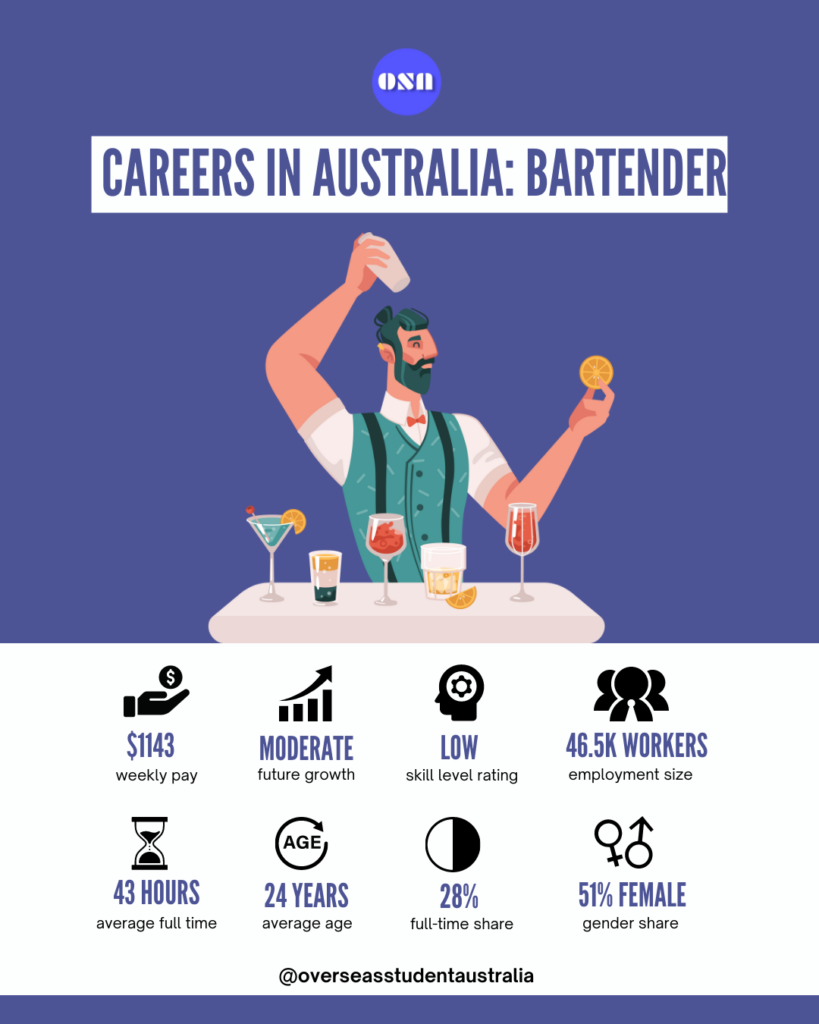How to Become a Bartender in Australia with Salary Guide

Do you enjoy mixing drinks and entertaining people while providing them with a welcoming and soothing atmosphere?
If so, bartending just might be a great career option for you!
In this article, you will discover all the necessary information needed on how to become a Bartender in Australia.
Who is a Bartender?
Bartender is a person who is responsible for preparing, mixing and serving alcohol to the patrons at licensed venues.
These venues could include bars, restaurants, casinos, taverns and others.
Bartending is a very delicate and technical job that requires good skills and knowledge of how to mix and serve drinks.
It also includes taking orders, keeping track of stock, and keeping the bar area clean and clean.
Bartending involves crafting unique and special cocktail mixes while providing an exceptional atmosphere. The role of a bartender goes beyond pouring drinks but giving customers a memorable experience of a lifetime!
Size of the Industry
There are over 46,500 bartenders in the Australian workforce currently. Statistics show that bartender and barista jobs are expected to grow by 7.7% by 2026, making this career a good choice.
Popular Locations
About 56% of the Bartenders live in capital cities in Australia.
New South Wales has the largest share of employers of bartenders in Australia relative to the size of its population.
Below is the percentage of bartenders in different areas of Australia by state and territory:
- New South Wales 42.4%
- Queensland 19.4%
- Victoria 17.6%
- Western Australia 8.8%
- South Australia 6.9%
- Tasmania 2.2%
- Australian Capital Territory 1.8%
- Northern Territory 0.9%
Industries Where Bartenders Are Needed
The Accommodation and Food Services industry employs up to 89.5% of the bartending workforce.
Other industries account for the remaining 10.5% of the bartending workforce population in Australia. The industries include:
- Arts and Recreation Services 5.1%
- Other Industries 2.5%
- Retail Trade 0.7%
- Manufacturing 0.6%
Hours of work
In Australia, around 28% of employed Bartenders work full-time hours in all their jobs combined.
Full-time workers work an average of 43 hours per week in their primary job.
This is similar to the working hours average for all jobs in Australia (44 hours per week).
Age
The average age of Bartenders in the Australian workforce is 24 years, which is younger than the all-jobs average of 40 years.
A large share of workers (36%) are within the age bracket of (20 to 24) years.
Gender
With over 46,500 bartenders in Australia, females account for 51% of the entire workforce, while males account for 49%.

What are some of the skills required to become a Bartender in Australia?
Here are some of the necessary skills you are required to have to become an exquisite bartender:
- Excellent Mixology skills
- Social skills
- Listening skills
- Time management
- Teamwork
- Physical Fitness
- Technical skills
- Creativity skills
- Conflict resolution skills
- Knowledge of local liquor laws and regulations
What are the tasks and duties of a Bartender in Australia?
Being a bartender requires great people skills and expertise in handling customers, inventory (drinks and equipment) and other tasks attached to the job role.
Here are some of the tasks and duties of a Bartender in Australia:
- Greeting customers and taking their orders: Bartenders are responsible for taking the customers’ orders and delivering them as quickly as possible.
- Preparing drinks: Bartenders are primarily responsible for preparing, mixing and serving drinks (both alcoholic and nonalcoholic) to the customers.
- Clean and maintain bar area: Hygiene and general cleanliness of the bar is very compulsory before opening up to customers. Bartenders are responsible for cleaning top surfaces and ensuring the bar is neat at regular intervals.
- Maintain inventory and alcohol supplies: Ensuring adequate and proper recording of stock supplies is a very important duty of the bartender. This helps in proper bookkeeping and preventing stock out of drinks and other bartending materials.
- Restocking Supplies: Just as bartenders take note of stock supplies, they also place orders to restock the bar.
- Adhere to legal requirements: Bar tenders must keep themselves up to date with the various liquor-related laws in Australia and in the state or territory they are going to work in. For example, the legal drinking age in Australia is 18 years or older.
- Keep track of daily sales: Bartending also involves keeping book records of the number of drinks sold, and the cash received at day end from sales.
- Create and update the drinks’ menu: As much as preparing drinks, bartenders prepare the drink menu and create several signature unique mixes on the menu for the customers.
- Communicate customers’ food orders to the kitchen: Asides from drinks, bartenders also take customers’ food orders in bar settings. They need to make sure to pass the information to the kitchen for prompt serving.
How much do Bartenders earn in Australia?
Bartenders’ salaries differ according to the region where they work, their experience in the industry, their qualifications and their employer.
However, average full-time earnings are $1143 per week. The average hourly pay for bartenders is $30.49.
The annual salary for a Bartender in Australia is around $59,000.
Essential steps to become a Bartender in Australia
If you want to become a bartender in Australia, there are some essential steps you need to follow.
It is important to know that before you can start a career in bartending you must be 18 years or older and must have completed your Year 12 education.
Although, there is no specific formal qualification required to become a Bartender in Australia, but having a certification to serve alcohol is a must.
The processes needed to become a bartender are as follows:
Step 1: Get a Responsible Service of Alcohol (RSA) Certificate
In Australia, if you work in the hospitality industry, you need an RSA certificate to sell or serve alcohol.
You are legally required to have this certification as a bartender as you will be dealing with alcohol and serving it to customers.
This is a short course that can be completed in less than a day through TAFEs and other hospitality and private training institutes.
If you would like to take this course, then you can check EOT as they are delivering this course online from $39 only.
If you would like to undertake this course, you can use one of the links below to register:
RSA course from $49 only (online) here:
- (All Australia except NSW, VIC) https://www.eot.edu.au/?pcid=1403
- VIC RSA: https://www.eot.edu.au/?pcid=1412
- NSW RSA: https://www.eot.edu.au/?pcid=1404
The cost of this course varies depending on your region. On average, this course costs $49 to $165 depending on if you are doing it online or face to face and the institution delivering the course.
Upon successful completion of this course, you will receive a Certificate of Attainment.
Step 2: Take Short Courses
As mentioned earlier, you don’t necessarily need to have formal qualifications to become a bartender, but having one will help in the long run.
You can take some informal courses or formal qualifications to level up the game in the industry.
Some of the informal short courses you can undertake include:
- Bartending Foundational Course
- Advanced Bartending Course
- Cocktail Making Course
These short courses can last from a day to a few weeks and can cost from 100 to $3000.
If you want to undertake a formal qualifications in the hospitality industry in Australia, then you can consider to
- Certificate II in hospitality
- Certificate III in hospitality
- Certificate IV in hospitality
These certifications can be completed within 6 to 12 months, depending upon the level and it can cost from $3000 to $15,000.
These certifications will not only help you learn about the hospitality industry but can help you stand out from the competition and demonstrate your expertise in the industry.
These certifications can also open up the door for other opportunities in the hospitality industry.
You can work in restaurants, hotels, parties, pubs, cruise ships, catering companies etc. This certification can be completed within 6 to 12 months.
Step 3: Gather Experience
Experience is everything in this industry.
When starting your career as a Bartender, you can work as a Barback or Bartender assistant before getting a full-time job as a bartender.
To learn how to be an excellent bartender, it’s best to work alongside an experienced bartender, so you can learn how things are done on the job.
Step 4: Build your network
Last but not the least, build your network by attending industry events and joining professional organisations.
This can help you stay up-to-date on industry trends and connect with other professionals in the field.
By following these essential steps, you can become a successful bartender in Australia and build a rewarding career in the hospitality industry.
Future growth of Bartending in Australia
The future growth of bartending is expected to increase positively due to so many factors.
The ever-growing hospitality industry in Australia has given rise to the need for more bartenders, creating a steady demand for them.
With the growing number of bars, hotels, and other hospitality venues, the demand for highly skilled bartenders who can create outstanding cocktails and exceptional customer experience.
Also, the positive influence of social media on this profession has made it a decent career choice.


